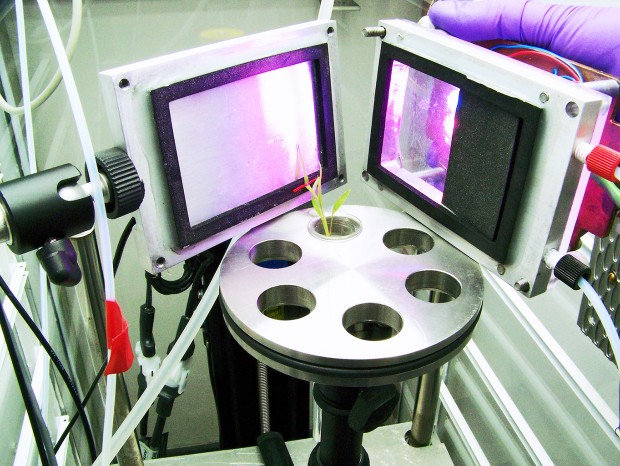
Agricultural News
Scientists Find New Research Models to Study Food Crops
Thu, 16 Jul 2015 15:13:48 CDT

Farmers often are required to apply nitrogen fertilizers to their crops to maintain quality and improve yields. Worldwide, farmers used more than 100 million tons of nitrogen in 2011, according to the United Nations Food and Agriculture Organization. In the same year, the U.S. alone produced and imported more than $37 billion in nitrogen. Now, researchers at the University of Missouri are working toward less reliance on nitrogen in plants, which could help decrease costs for farmers, develop heartier plants, eliminate runoff in water supplies and provide food for a growing global population.
Fernanda Amaral, an MU postdoctoral fellow and researcher in the Bond Life Sciences Center, found that less dependence on nitrogen could start with a simple type of grass, Setaria viridis, and its relationship with naturally occurring bacteria.
"Biological nitrogen fixation where bacteria fix atmospheric nitrogen and convert it to ammonium provides a free way for plants to assimilate and metabolize nitrogen," Amaral said. "Farmers have long known that legumes like soybeans fix nitrogen because of the symbiosis between the plant and bacteria in the soil. Normally, plants develop nodules on their roots. However, since grass plants that produce food, such as corn, rice and sugarcane, don't form these specialized structures, that relationship has been trickier to explore in these plants. Therefore, we needed a plant model to help us study how nitrogen fixation naturally happens."
Amaral worked with Gary Stacey, MSMC Endowed Professor of Plant Sciences and Biochemistry at MU, as well as scientists in Brazil from the Federal University of Paraná and University of Santa Catarina to find a plant model system that would be easy to germinate, small enough to study and already had a sequenced genome. They screened more than 30 genotypes of Setaria viridis grass looking for a strong nitrogen fixing response when three different bacteria strains were introduced.
Plants then were transplanted into soil containing no nutrients. By eliminating nitrogen in the soil, the scientists were able to assure that bacteria was the only source of nitrogen for the grass plants they were studying.
Proving that the bacteria truly fixed the nitrogen used by the plant, required exposing plants to radioactive isotopes at Brookhaven National Laboratory in New York. That began with Nitrogen 13, an unstable radioisotope that showed exactly where and how quickly this nutrient was taken up from the bacteria. The team determined that Azospirillum brasilense bacteria, which has been used commercially in South America to improve crop plant growth, was the best choice.
"We wanted to identify the genes responsible for the interaction between plant and bacteria and mainly the ones involved with the nitrogen uptake," Amaral said. "By identifying the bacteria that allows plants to take in nitrogen, we may have found a more efficient and eco-friendly way to farm. Setaria viridis grass can serve as a simple model for research and can substitute for grass relatives such as corn and rice. Further studies may explore a similar relationship in those food crops and could lead to a plant friendly way to promote more sustainable agriculture."
The study, "Robust biological nitrogen fixation in a model grass bacterial association," was published in The Plant Journal. Funding for this project was provided by the National Institute of Science and Technology Biological Nitrogen Fixation, the Brazilian Research Council, Ciência Sem Fronteiras Program, The Department of Energy and SUNY School of Environmental Science and Forestry Honors Internship Program. The content is solely the responsibility of the authors and does not necessarily represent the official views of the funding agencies.
For more on this story, please see "Move over Arabidopsis, there's a new model plant in town."
WebReadyTM Powered by WireReady® NSI
Top Agricultural News
More Headlines...




















